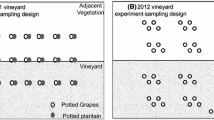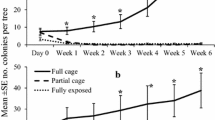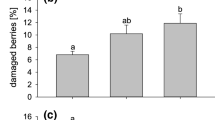Abstract
The impact of native natural enemies on populations of the grape mealybug,Pseudococcus maritimus (Ehrhorn) in apple and pear orchards was assessed using a combination of techniques, including exclusion cages, limb-banding, and visual inspection of shoots and fruits. The complex of native natural enemies (which included two encyrtid parasitoids, (Pseudaphycus websteri Timberlake andMayridia species), a coccinellid beetle (Hyperaspis lateralis Mulsant), and a chamaemyiid fly (Leucopis verticalis Malloch), provided reasonably good control in orchards that had not been treated with insecticides for one to two years. However, surveys indicated that most of these species were absent from orchards regularly sprayed with pesticides.
Résumé
L'effet des ennemis naturels indigènes sur les populations dePseudococcus maritimus (Ehrhorn) dans les vergers de pommiers et de poiriers a été évalué en utilisant un ensemble de techniques, comprenant des cages d'exclusion, des bandes de toile placées sur les grosses branches et une inspection visuelle des pousses et des fruits. Le complexe d'ennemis naturels indigènes (qui comprend deux parasitoïdes encyrtides (Pseudaphycus websteri Timberlake et les espèces du genreMayridia), une coccinelle (Hyperaspis lateralis Mulsant), et une mouche chamaemyide (Leucopis verticalis Malloch) donne un assez bon résultat dans les vergers qui n'ont pas été traités avec des insecticides pendant l'année ou les deux années précédentes. Cependant la plupart de ces espèces étaient absentes des vergers régulièrement traitées avec des pesticides.
Similar content being viewed by others
References
Agnello, A. M., Spangler, S. M., Reissig, W. H., Lawson, D. S. &Weires, R. W.—1992. Seasonal development and management strategies for Comstock mealybug (Homoptera: Pseudococcidae) in New York pear orchards.—J. Econ. Entomol., 85, 212–225.
Doutt, R. L. &Hagen, K. S.—1950. Biological control measures applied againstPseudococcus maritimus on Pears.—J. Econ. Entomol., 43, 94–96.
Grimes, E. W. &Cone, W. W.—1985. Life history, sex attraction, mating, and natural enemies of the grape mealybug,Pseudococcus maritimus (Homoptera: Pseudococcidae).—Ann. Entomol. Soc. Am., 78, 554–558.
Hill, W. B. &Burts, E. C.—1982. Grape mealybug (Homoptera: Pseudococcidae) on pear in north-central Washington.—J. Econ. Entomol., 75, 501–503.
Luck, R. F., Shepard, B. M. &Kenmore, P. E.—1988. Experimental methods for evaluating arthropod natural enemies.—Ann. Rev. Entomol., 33, 367–391.
SAS Institute Inc.—1988. SAS/STAT user's guide, release 6.03 edition.—Cary, NC: SAS Institute Inc. 1 028 pp.
Author information
Authors and Affiliations
Rights and permissions
About this article
Cite this article
Grasswitz, T.R., Burts, E.C. Effect of native natural enemies on the population dynamics of the grape mealybug,Pseudococcus maritimus (Hom.: Pseudococcidae), in apple and pear orchards. Entomophaga 40, 105–117 (1995). https://doi.org/10.1007/BF02372686
Received:
Accepted:
Issue Date:
DOI: https://doi.org/10.1007/BF02372686




